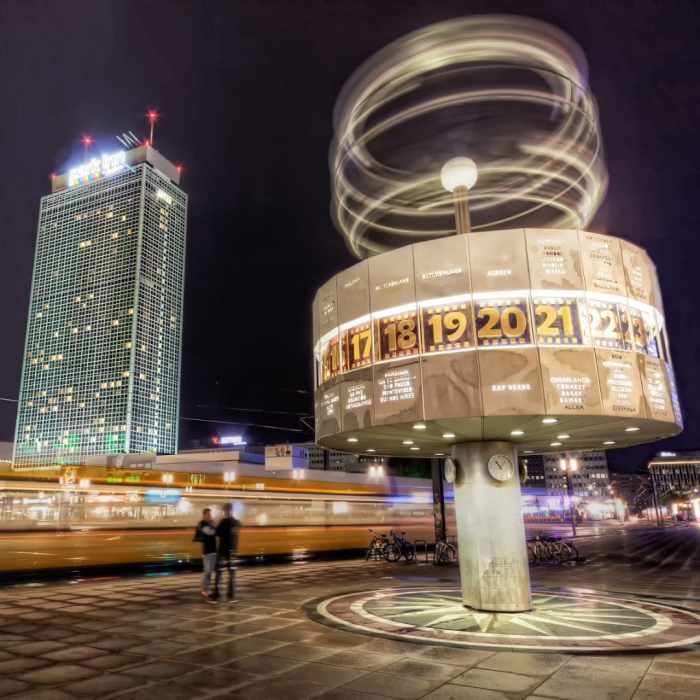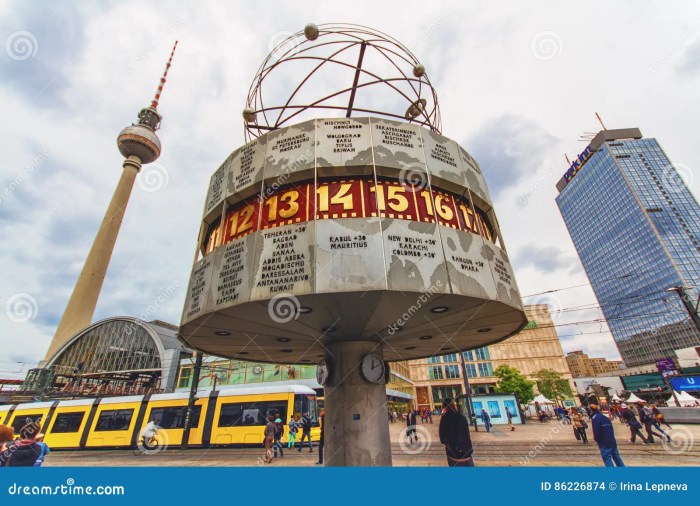Berlin time, a historical time zone that played a pivotal role in shaping timekeeping in Germany and beyond, continues to hold cultural and practical significance today. Its journey through history, from its inception to its current use, is a testament to the evolving nature of time and its impact on human societies.
Throughout the centuries, Berlin time has influenced daily life, transportation, business, and social activities in the city. It has also left its mark on art, literature, and music, inspiring notable references and cultural expressions.
Historical Significance

Berlin time played a pivotal role in the development of modern timekeeping, becoming the standard time zone for much of Central Europe.
In 1893, the International Meridian Conference established the Prime Meridian at Greenwich, England, and divided the globe into 24 time zones. Berlin, being close to the 15th degree of longitude east of Greenwich, adopted Central European Time (CET), which was one hour ahead of Greenwich Mean Time (GMT).
Adoption and Use
CET was widely adopted in Germany and other Central European countries, including Austria, Hungary, and Switzerland. It became the official time zone for these nations, coordinating schedules, transportation, and communication.
During World War I, Germany introduced daylight saving time (DST) to conserve energy. This practice was later adopted by many other countries, further solidifying Berlin time’s influence on global timekeeping.
If you’re planning a trip to Berlin, be sure to check out the city’s many eco-friendly attractions. From bike paths to green spaces, there are plenty of ways to explore Berlin without harming the environment. For more tips on how to travel sustainably, check out our guide to eco-friendly travel tips.
Once you’ve explored Berlin’s eco-friendly side, be sure to check out the city’s many historical landmarks. From the Brandenburg Gate to the Reichstag, there’s plenty to see and do in Berlin.
Relationship to Central European Time (CET)

Berlin time has a close connection with Central European Time (CET), which is the standard time used in most of Central Europe. CET is one hour ahead of Coordinated Universal Time (UTC) and is calculated based on the mean solar time of the 15th meridian east of Greenwich.
Berlin time was originally established as the local mean solar time of the city of Berlin. However, in 1893, Germany adopted CET as its standard time, and Berlin time was synchronized with it.
Transition from Berlin time to CET
The transition from Berlin time to CET had several impacts:
- It simplified timekeeping and coordination within Germany and with neighboring countries that also adopted CET.
- It led to a slight shift in the time of sunrise and sunset in Berlin, as the city is located slightly east of the 15th meridian.
- It required adjustments to clocks and timetables to reflect the one-hour difference.
Time Zone Variations: Berlin Time

Berlin’s time zone has undergone several changes throughout history, primarily due to political and economic factors.
One notable change occurred in 1945, following the end of World War II. Berlin was divided into four sectors occupied by the Allied powers, each with its own time zone. The Soviet sector adopted Eastern European Time (EET), while the other three sectors remained on Central European Time (CET).
Post-War Period
- 1945: Berlin divided into four sectors, each with its own time zone.
- 1949: Federal Republic of Germany (West Germany) established, adopting CET.
- 1949: German Democratic Republic (East Germany) established, adopting EET.
Impact on Daily Life
Berlin time had a profound impact on daily life in the city. It influenced transportation schedules, business hours, and social activities, shaping the rhythm of life for Berliners.
Berlin Time is six hours ahead of Coordinated Universal Time (UTC). If you’re planning a trip to Alaska, keep in mind that the Alaska Marine Highway operates a ferry system that connects several coastal communities in Alaska. The ferry system is a great way to experience the stunning scenery of Alaska’s Inside Passage.
Berlin Time is six hours ahead of Alaska Time, so be sure to adjust your watch when you arrive in Alaska.
Transportation
Berlin time played a crucial role in coordinating transportation within the city and beyond. Public transportation, such as buses and trains, operated on timetables that were synchronized with the official time, ensuring smooth and efficient movement of people.
Business Hours
Businesses in Berlin typically adhered to the established time zone, opening and closing their doors at specific times. This allowed for coordination between different businesses, as well as with customers and clients. The standardized time zone facilitated efficient communication and scheduling.
Berlin time is known for its accuracy and precision. It is the official time zone for Germany and is used in many other countries in Central Europe. However, when traveling to other parts of the world, it is important to be aware of the time difference.
For example, when traveling to Chennai, India, the time difference is 4 hours and 30 minutes ahead of Berlin time. This means that when it is 12:00 pm in Berlin, it is 4:30 pm in Chennai. You can find more information about the time difference between Berlin and Chennai and chennai.
Social Activities
Social activities in Berlin were also influenced by Berlin time. Events such as concerts, theater performances, and sporting events had fixed start times, allowing people to plan their schedules accordingly. The shared time reference provided a common framework for social gatherings and interactions.
Cultural Significance
Berlin time holds a profound cultural significance in art, literature, and music, serving as a symbol of the city’s rich history, vibrant culture, and enduring legacy.
In literature, Berlin time often serves as a backdrop for stories that explore the city’s unique atmosphere and the lives of its inhabitants. For example, Alfred Döblin’s novel “Berlin Alexanderplatz” captures the rhythm and pulse of the city in the 1920s, with references to specific times and locations that evoke a vivid sense of place and time.
In Music
Berlin time has also played a significant role in the development of music, particularly in the realm of electronic dance music (EDM). The city’s thriving nightlife scene and its abundance of nightclubs have fostered a unique musical culture that revolves around the concept of “Berlin time.”
- Berlin time in EDM typically refers to a tempo of 120-130 beats per minute (BPM), which creates a distinctive, driving rhythm that is often associated with the city’s nightlife.
- Artists such as Kraftwerk, Tangerine Dream, and Paul van Dyk have been instrumental in popularizing Berlin time and shaping the sound of EDM.
Comparison to Other Time Zones

Berlin time is in the Central European Time (CET) zone, which is one hour ahead of Coordinated Universal Time (UTC) and two hours ahead of Greenwich Mean Time (GMT). This places it in the same time zone as most of Central and Eastern Europe, including countries like France, Italy, Poland, and Hungary.
Compared to other major time zones around the world, Berlin time is:
- Eight hours ahead of Pacific Standard Time (PST) in the United States.
- Six hours ahead of Eastern Standard Time (EST) in the United States.
- Five hours ahead of Coordinated Universal Time (UTC).
- Two hours ahead of Greenwich Mean Time (GMT).
- One hour ahead of Western European Time (WET).
- Seven hours behind Japan Standard Time (JST).
- Ten hours behind Australian Eastern Standard Time (AEST).
These differences in timekeeping practices can have a significant impact on communication and coordination between people in different parts of the world. For example, a business meeting scheduled for 9 am in Berlin would take place at 1 am in Los Angeles, California, and 8 pm the previous day in Sydney, Australia.
Current Use and Relevance
Berlin time continues to be used in Germany, primarily in the eastern part of the country, including the capital city of Berlin. It is also used in parts of Poland, the Czech Republic, and Slovakia.
Historically and culturally, Berlin time holds significance as it was the standard time zone for Germany during the 19th and early 20th centuries. It played a crucial role in coordinating railway schedules and communication across the country.
Relevance in Historical and Cultural Contexts, Berlin time
- Berlin time served as the standard time zone for the German Empire from 1893 to 1918, contributing to the country’s economic and industrial development.
- During the Cold War, Berlin time was used in both East and West Germany, symbolizing the division and reunification of the country.
- Today, Berlin time remains a cultural reference point, particularly in the eastern part of Germany, where it is often referred to as “Mittel-Europäische Zeit” (Central European Time) or “MEZ.”
Outcome Summary

Berlin time, a time zone steeped in history and cultural significance, remains relevant in contemporary times. Its legacy continues to shape the way we perceive time and its impact on our daily lives. Whether exploring its historical significance, its connection to Central European Time, or its influence on Berlin’s vibrant culture, Berlin time offers a fascinating glimpse into the interplay between time and human experience.
Question & Answer Hub
What is the difference between Berlin time and Central European Time?
Berlin time is one hour ahead of Central European Time (CET) during standard time and two hours ahead during daylight saving time.
When did Berlin time transition to Central European Time?
Berlin time officially transitioned to Central European Time on April 1, 1919.
What are some examples of the cultural significance of Berlin time?
Berlin time has been referenced in works of art, literature, and music, including paintings by Ernst Ludwig Kirchner and songs by David Bowie.